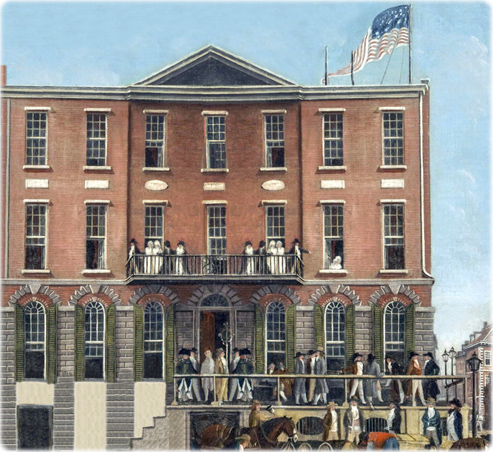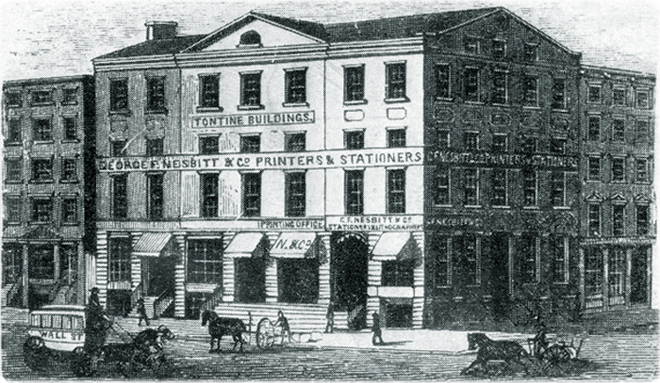
Tontine Coffee-House
The Tontine Coffee-House was built on Wall Street, on the northwest corner of Water Street in 1792-1793. It was an historic meeting place for merchants and traders and also operated as a lodging house. The site formerly housed the old Merchant’s Coffee House and old taverns. In 1834, the premises changed for general purpose and it became the "Tontine Building" in 1843. It was demolished in the spring 1855 and replaced by a new Tontine Building.
The old Merchant’s Coffee House, established in the 1730s, opened on the same site, but it burned in 1804 and moved later to the opposite side of Wall Street.
The Tontine Coffee-House was built on a tontine Plan, which is a system for raising capital in which individuals pay into a common pool of money and receive dividends based on their share of returns from investments made with the pooled money, for the rest of their lives, a kind of pension. As members die, their payout entitlements devolve to the other participants, and so the value of each continuing payout increases. The name comes from the Neapolitan banker Lorenzo de Tonti (c.1602-c.1684). Tonti first proposed this plan, in 1656, to Cardinal Mazarin, who served as the chief minister to the Kings of France Louis XIII and Louis XIV. The Parliament, however, refused to register the venture and the plan was nicknamed the tontine. Tonti lost royal patronage and ended up as a prisoner in the Bastille for unknown reason. Later, Louis XIV used the tontine plan to raise money, apparently with successful results.
The committee of the association of merchants to build this coffee house established funds by selling 203 shares at £200 a share.
See a subscription receipt for the Tontine Coffee-House below, signed by David Grim.
The association bought the house and lot, where the original Merchants' Coffee House stood and acquired the adjoining lots on Wall and Water streets. The cornerstone of the new coffee house was laid June 5, 1792 and the building was completed by June, 1793.
The constitution of this tontine plan bore the date of June 4, 1794, but the nominations by the subscribers were not wholly completed until March, 1795. The Association, in their preamble, named the building the Tontine Coffee-House, and it was thereby directed to be kept and used as a coffee-house.
The New York Stock Exchange, originally founded in 1792, was formally organized here in 1817.
In the 1830s, George F. Nesbitt moved his printing business from 117 Water Street to the Tontine Building, across the street. His extensive steam printing and stationary establishment supplied the needs of a vast commercial community. Nesbitt occupied this premises until 1855, when the building was demolished.
In 1827, the Merchants' Exchange opened on Wall Street and the interests of the Tontine Coffee-House shareholders demanded a change in its special appropriation as a coffee-house. They applied to the Court of Chancery for permission to let the premises for general purposes, and by its decree in 1834 the restrictions were removed. The name of the premises was altered to "Tontine Building". In 1843, the legislature passed and act confirming the revised statutes of the Tontine Building, managed by "The Committee of the Tontine Building".
In 1836, the Tontine Building became the first quarters of the New York Daily Express. This newspaper was established in the same year by James Brooks.
In May 1855, 51 subscribers of the original Tontine Coffee-House still survived. Some of them were children when the subscription was made. That year, the property was leased to William H. Aspinwall (1807-1875), co-founder of the Pacific Mail Steamship Company and the Panama Canal Railway. The old Tontine Building, former Tontine Coffee-House, was razed in May 1855 to make way for the second Tontine Building, constructed in the same year, on the same site. It was designed by James Renwick (1818-1895). At the time, Fredrick de Peyster was the chairman of the committee who managed its affairs.
The statutes of the Tontine Association allowed its assets to be divided and distributed, when only seven of the original subscribers were alive. This happened when John P. de Wint died on November 16, 1870. In 1873, Frederic de Peyster and William T. Horn brought a suit in the Supreme Court to determine the interest of the various owners in the assets of the association. The matter was referred to William B. Winterton, as referee, and he advised a sale by auction, which the court ordered to take place on January 11, 1881. The property, comprising numbers 84, 86 and 88 Wall Street, was knocked down to Peter J. O'Donohue, a tea merchant. After that, the Tontine Association closed.
The Tontine Building was demolished in 1901 to make was for an early skyscraper of the same name, today the Wall Street Hotel.
Above, Tontine Coffee House on Wall Street, corner of Water Street in the late 18th century. Illustration adapted from the Francis Guy painting and the engraving by Ge. Holland. Below, another adaptation based on Geo. Holland (click on images toe see originals).

and the Tontine Association

The first Tontine Building in 1840, when it was occupied by Nesbitt & Co. Source: NYPL. This was the former Tontine Coffee-House.
|
Copyright © Geographic Guide - Images of NYC, Historic Buildings. |
Receipt to Peter Allaire on account of his subscription towards building a coffee house on a tontine plan, dated January 14, 1793, signed by David Grim, by order of the committee. The Tontine Coffee House was then under construction. Peter Allaire (1740-1820), a New York merchant, was better known for being a British spy during the Independence War (1755-1783).
Tontine Coffee-House